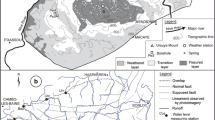Abstract
Karst aquifers are characterized by spatial heterogeneity due to the presence of highly permeable channels and conduits in low-permeable fractured rocks (matrix block). Recent studies have reported a close relationship between surface and subsurface water in karstic regions due to the water flow through a complicated network of paths formed by fracture intersections. Subsurface flow in karstified aquifers ranges between conduit flow, in large passages with relatively high flow velocities, and diffuse flow, in the matrix block where Darcy’s law is still valid. In this paper, we present the simulation of a complex karstified aquifer system in Crete, Greece, where the presence of main faults drastically affects the regional flow. A discrete fracture approach in conjunction with an equivalent porous medium approach was adopted to simulate the mixed flow in the area of interest. The simulation results have shown that the length and the orientation of the dominant faults, primarily during the rainy season, affect the flow field.










Similar content being viewed by others
References
Anderson, M. P., & Woessner, W. W. (1992). Applied Groundwater Modeling Simulation of Flow and Advective Transport. San Diego: Academic Press.
ASTM. (1995). Standard guide for design of groundwater monitoring systems in karst and fractured-rock aquifers, D 5717–95. West Conshohocken: American Society for Testing and Materials.
Berkowitz, B. (2002). Characterizing flow and transport in fractured geological media: A review. Advances in Water Resources, 25, 861–884.
Charbeneau, R. J. (2000). Groundwater Hydraulics and Pollutant Transport. Upper Saddle River, NJ: Prentice Hall.
Freeze, R. A., & Cherry, J. A. (1979). Groundwater. Englewood Cliffs, NJ: Prentice Hall.
Hamm, S.-Y., Kim, Moon Su, Cheong, J.-Y., Kim, J.-Y., Son, M., & Kim, T.-W. (2007). Relationship between hydraulic conductivity and fracture properties estimated from packer tests and borehole data in a fractured granite. Engineering Geology, 92, 73–87.
Harbaugh, A. W., Banta, E. R., Hill, M. C., & McDonald, M. G. (2000). User guide to modularization concepts and the Ground-Water Flow Process, MODFLOW-2000 the US Geological Survey modular ground-water model, US Geological Survey Open-File Report 00-92, pp. 121.
Jaquet, O., Siegel, P., Klubertanz, G., & Benabderrhamane, H. (2004). Stochastic discrete model of karstic networks. Advances in Water Resources, 27, 751–760.
Karterakis, S. M., Karatzas, G. P., Nikolos, I. K., & Papadopoulou, M. P. (2007). Application of linear programming and differential evolutionary optimization methodologies for the solution of coastal subsurface water management problems subject to environmental criteria. Journal of Hydrology, 342, 270–282.
Κoukadaki, M. A., Karatzas, G. P., Papadopoulou, M. P., & Vafidis, A. (2007). Identification of the saline zone in a coastal aquifer using electrical tomography data and simulation. Water Resources Management, 21, 1881–1898.
Novakowski, K., Bickerton, G., Lapcevic, P., Voralek, J., & Ross, N. (2006). Measurements of groundwater velocity in discrete rock fractures. Journal of Contaminant Hydrology, 82, 44–60.
Papadopoulou M. P., Varouchakis, E. A., and Karatzas, G. P. (2007). A Study of the Complex Karstification Phenomenon in Nature: An Analysis of the Flow in a Fractured Medium in Crete. Proceedings of the 10th International Conference on Environmental Science and Technology, Vol. A, pp. 1109–1116, Kos Island, Greece.
Papadopoulou, M. P., Varouchakis, E. A., & Karatzas, G. P. (2009). Simulation of complex aquifer behavior using numerical and geostatistical methodologies. Desalination, 237, 42–53.
Park, B. Y., Kim, K. S., Kwon, S., Kim, C., Bae, D. S., Hartley, L. J., et al. (2002). Determination of the hydraulic conductivity components using a three-dimensional fracture network model in volcanic rock. Engineering Geology, 66, 127–141.
Park, E., & Zhan, H. (2003). Hydraulics of horizontal wells in fractured shallow aquifer systems. Journal of Hydrology, 281, 147–158.
Quinn, J. J., Tomasko, D., & Kuiper, J. A. (2006). Modeling complex flow in a karst aquifer. Sedimetary Geology, 184, 343–351.
Samardzioska, T., & Popov, V. (2005). Numerical comparison of the equivalent continuum, non-homogeneous and dual porosity models for flow and transport in fractured porous media. Advances in Water Resources, 28, 235–255.
Scanlon, B. R., Mace, R. E., Barrett, M. E., & Smith, B. (2003). Can we simulate regional groundwater flow in a karst system using equivalent porous media models? Case Study, Barton Springs Edwards aquifer USA. Journal of Hydrology, 276, 137–158.
US DOE. (1982). Site characterization report for the Basalt Waste Isolation Project, DOE/RL 82-3. Prepared by Rockwell Hanford Operations, November.
Visual MODFLOW (1995–2006). Modular three-dimensional finite-difference ground-water FLOW model, Version 4.2, Waterloo Hydrogeologic, Inc.
Author information
Authors and Affiliations
Corresponding author
Rights and permissions
About this article
Cite this article
Papadopoulou, M.P., Varouchakis, E.A. & Karatzas, G.P. Terrain Discontinuity Effects in the Regional Flow of a Complex Karstified Aquifer. Environ Model Assess 15, 319–328 (2010). https://doi.org/10.1007/s10666-009-9207-5
Received:
Accepted:
Published:
Issue Date:
DOI: https://doi.org/10.1007/s10666-009-9207-5




